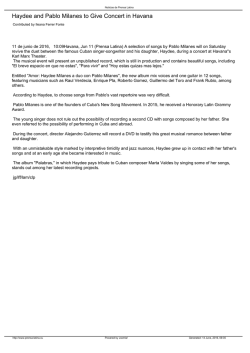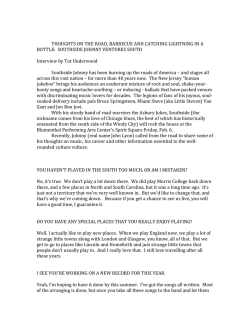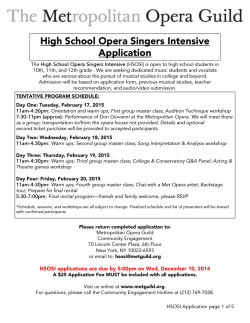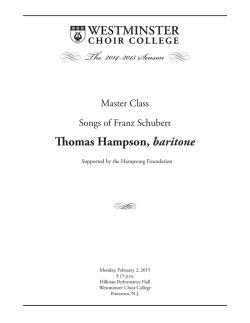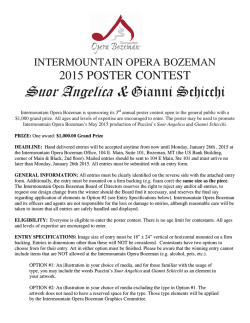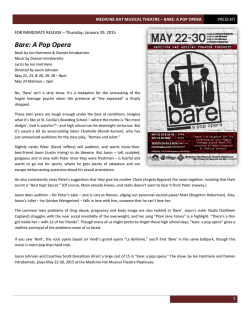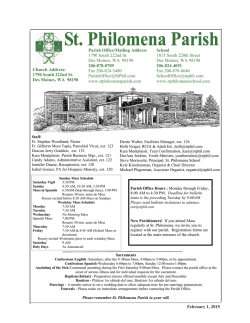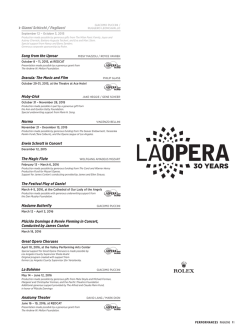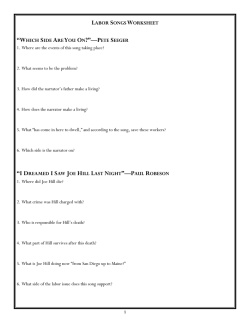
Matthew Polenzani, tenor Julius Drake, piano
Saturday, January 31, 2015, 8pm First Congregational Church Matthew Polenzani, tenor Julius Drake, piano PROGRAM Ludwig van Beethoven (1770–1827) Adelaide, Op. 46 (1794–1795) Franz Liszt (1811–1886) Der Glückliche, K. 334 (1878) Wie singt die Lerche schön, K. 312 (1855) Die stille Wasserrose, K. 321 (1860) Im Rhein, im schönen Strome, K. 272 (1840) Es rauschen die Winde, K. 294 (1845) Liszt Four Songs on Poems of Victor Hugo S’il est un charmant gazon, K. 284 (1844) Enfant, si j’étais roi, K. 283 (1844) Comment, disaient-ils, K. 276 (1842) Oh! quand je dors, K. 282 (1844) INTERMISSION CAL PERFORMANCES PROGRAM Erik Satie (1866–1925) Trois Mélodies (1914) La statue de bronze Daphénéo Le chapelier Maurice Ravel (1875–1937) Cinq Mélodies Populaires Grecques (1904–1906) Chanson de la mariée Là-bas, vers l’église Quel galant m’est comparable Chanson des cueilleuses de lentisques Tout gai! Samuel Barber (1910–1981) Hermit Songs, Op. 29 (1952–1953) At Saint Patrick’s Purgatory Church Bells at Night St. Ita’s Vision The Heavenly Banquet The Crucifixion Sea-Snatch Promiscuity The Monk and His Cat The Praise of God The Desire for Hermitage Funded, in part, by the Koret Foundation, this performance is part of Cal Performances’ 2014–2015 Koret Recital Series, which brings world-class artists to our community. This performance is made possible, in part, by Patron Sponsor Bernice Greene. Cal Performances’ 2014–2015 season is sponsored by Wells Fargo. PLAYBILL PROGRAM NOTES Ludwig van Beethoven (1770–1827) Adelaide, Op. 46 (1794–1795) In November 1792, the 22-year-old Ludwig van Beethoven, full of talent and promise, arrived in Vienna from his native Bonn. During his first years in the city, he was busy on several fronts. Initial encouragement for the Viennese junket came from the venerable Joseph Haydn, who had heard one of Beethoven’s cantatas on a visit to Bonn earlier in the year and promised to take the young composer as a student if he came to see him. Beethoven, therefore, became a counterpoint pupil of Haydn immediately after his arrival, but the two had difficulty getting along, and their association soon broke off. Several other teachers followed in short order: Schenk, Albrechtsberger, Förster, Salieri. While he was busy completing fugal exercises and practicing setting Italian texts for his tutors, he continued to compose, producing works for solo piano, chamber ensembles and wind groups. It was as a pianist, however, that he gained his first fame among the Viennese. The untamed, passionate, original quality of his playing and his personality first intrigued and then captivated those who heard him. When he bested in competition Daniel Steibelt and Joseph Wölffl, two of the town’s noted keyboard luminaries, he became all the rage among the gentry, who exhibited him in performance at the soirées in their elegant city palaces. In catering to the aristocratic audience, Beethoven took on the air of a dandy for a while, dressing in smart clothes, learning to dance (badly), buying a horse, and even sporting a powdered wig. This phase of his life did not outlast the 1790s, but in Peter Latham’s biography of the composer, Latham described Beethoven at that time as “a young giant exulting in his strength and his success, and youthful confidence gave him a buoyancy that was both attractive and infectious.” To demonstrate that his skill as a composer went beyond the chamber and piano pieces he had produced since arriving in Vienna in 1792, in 1794 Beethoven undertook an ambitious setting for voice and piano—a “cantata,” he called it—of the poem Adelaide by the popular author Friedrich von Matthison. It is possible that the work was conceived for, and perhaps inspired by, Magdalena Willmann, a talented singer and a beautiful woman Beethoven had known in Bonn who came to Vienna in 1794 to pursue her career. Beethoven conceived a passion for Magdalena strong enough that he was rumored to have proposed marriage to her. It was the first of the composer’s several fruitless attempts to find a wife. She turned him down rudely (the composer’s biographer Alexander Weelock Thayer reported the girl’s sister as saying that Beethoven was “too ugly and half demented”), but she remained sufficiently in touch with him to sing Adelaide at her Vienna concert of April 7, 1797, the work’s first known public performance. In Matthison’s verse, the poet provides the lonely lover with solace and metaphor through the images of nature that formed the essential material of the German poetry of that time. Songs by Franz Liszt (1811–1886) Liszt’s first song was a lullaby written in 1839 for his four-year-old daughter, Blandine. Later that year, he set three sonnets by Petrarch, which also served as the thematic germs for three movements in the second volume of his Années de Pèlerinage (“Years of Pilgrimage”). The 82 songs that came to comprise his output in this genre over the next 44 years reflect the dazzling cosmopolitanism of his life: 58 are in German, 14 in French, five in Italian, three in Hungarian, and one each in Russian and English. As with the Petrarch sonnets, he arranged some two dozen of his songs for piano, and orchestrated eight of them. The genre proved to be a congenial one for Liszt’s lyrical and poetic gifts, and his best songs present a distillation of the finest qualities of his unique genius. Der Glückliche (“The Happy One,” 1878), yet another expression of the German Romantics’ intimate association of love and CAL PERFORMANCES PROGRAM NOTES nature, is based on a poem by the novelist, playwright, journalist and poet Adolf von Wilbrandt (1837–1911), who married the actress Auguste Baudius and directed Vienna’s Hofburgtheater during the 1880s. Wie singt die Lerche schön (“How Lovely Sings the Lark,” 1855) is a vernal setting of a poem by August Heinrich Hoffmann von Fallersleben (1798–1874), a close friend of Liszt and a German patriotic poet, philologist and literary historian whose verse Deutschland, Deutschland über alles was adopted as Germany’s national anthem after World War I. Poet, translator, teacher, and playwright Emanuel von Geibel (1815–1884), the son of a pastor in Lübeck, began his career as a tutor in Athens before being called back to Germany to work at courts and universities in Berlin and Munich. Geibel wrote a half-dozen dramas, translated Spanish and French poetry, and aligned himself with other progressive literary figures who supported the political upheavals of 1848, but he is mainly remembered for his lyric poems, which the German Romantic composers made the basis of hundreds of songs. Liszt’s Die stille Wasserrose (“The Quiet Water Rose,” 1860) suggests the quiet melancholy of Geibel’s verse. By 1840, Heinrich Heine, born in 1797 to Jewish parents in Düsseldorf, had been living for a decade in Paris. Though given an advantageous upbringing, he was a poor student, incapable of holding a regular job (he reluctantly converted to Protestantism in 1825 to try for work in the civil service, then closed to Jews, but never got a government position) and outspoken about what he saw as the repressive qualities of German life. He did, however, find success in writing, establishing his reputation with the 1823 Lyrisches Intermezzo, which tempered the sentimentality and folkish simplicity of much German Romantic poetry with bittersweet irony and a sometimes corrosive wit. With his republican sympathies stirred by the July Revolution of 1830 in Paris, Heine moved to France the following year, writing political essays (some PLAYBILL published in Karl Marx’s newspaper Vorwärts [“Forward”]), studies of German culture (in French), and articles about French life and politics, in addition to collections of new, sharper-edged poems. Though he was largely confined to what he called his “mattressgrave” by paralysis, pain and partial blindness apparently caused by venereal disease during the eight years before he died in Paris in February 1856, Heine continued to write, maintaining his standing as one of the day’s most widely read but controversial authors. Heine and Liszt were both active supporters of the ongoing project to complete the great Cologne Cathedral, begun in 1248 but not finished until 1880, and they expressed their dedication to the cause in Im Rhein, im schönen Strome ( “In the Rhine, in the Fair Stream,”1840), which finds the Romantic poet likening his beloved to a representation of the Madonna within the Gothic structure. Ludwig Rellstab (1799–1860) was a prominent music critic in Berlin and a writer of high ambitions who is remembered for coining the well-known sobriquet of Beethoven’s Piano Sonata in C-sharp minor, Op. 27, No. 2, by describing it as “a vision of a boat on Lake Lucerne by moonlight.” His poems were popular with the German Romantic composers (seven songs in Schubert’s Schwanengesang are based on Rellstab’s verses) and in 1845, three years after Rellstab had praised his appearances in Berlin, Liszt made a dark, agitated setting of his Es rauschen die Winde (“Rushing Are the Winds”). S’il est un charmant gazon (“If There Be a Lovely Lawn,” 1844, from Liszt’s friend Victor Hugo’s 1834 poetry collection Les Chants du Crépuscule [“Songs at Twilight”]) is luminous and vernal. Liszt’s settings of Hugo’s Enfant, si j’étais roi (“My Child, If I Were King,” from Les Feuilles d’automne [“Autumn Leaves,” 1829]) and Oh! quand je dors (“Oh, While I Sleep,” from Les Rayons et les Ombres [“Rays and Shadows,” 1840]) also date from about 1844, when the composer-pianist’s standing as the musical darling of Paris was at its height. These are among Liszt’s most expressive and PROGRAM NOTES sensual songs, and the Dutch musicologist Frits Noske noted, “Hugo’s language, so rich in imagery, has only rarely found such a worthy musical equivalent as in Oh! quand je dors.” Comment, disaient-ils (“‘How,’ They Asked,” 1842, from Hugo’s Les Rayons et les Ombres) creates a charming dialogue between the anxious enquiries of the young lovers and the soothing replies of their sweethearts. Erik Satie (1866–1925) Three Songs (1914) The American photographer and writer of music and literature Carl van Vechten gave the following description of Erik Satie: “A shy and genial fantasist, part-child, part-devil, part-faun,” who was “played on by Impressionism, Catholicism, Rosicrucianism, Pre-Raphaelitism, Theosophy, the camaraderie of the cabaret.” The character of Satie is as difficult to define as this sketch implies. He was friend and influence to the best creative minds in Paris during the decadent era surrounding the turn of the 20th century, yet he lived in cheerful poverty in a distant suburb. He was given to mysticism, but wrote music intended to arouse absolutely no passion. He ascribed fantastic, seemingly deprecatory titles to works (Pieces in the Form of a Pear, Five Grimaces, Desiccated Embryos, Posthumous Preludes) that offered one of the few viable alternatives to the pervasive tide of Wagnerism sweeping Europe at the end of the 19th century. The path he opened led the way not only toward the Impressionism of Debussy (a close friend for some 25 years) and Ravel, but also to the French avant-garde movement of Les Six, and, closer to our time, the minimalism of Terry Riley and Philip Glass. Satie’s style was based on austere simplicity of technique and expression. At a time in the history of music when bigger (i.e., longer, louder, more cathartic, or more complex) was assumed to be better, he proposed an art of quiet purity and emotional distancing that led away from the intense Romanticism of the late 19th century to the clarity and restraint that had marked French art in earlier eras. Satie’s 32 songs are spread thinly but evenly across his career, from the cabaret-influenced Trois Mélodies of 1886 to the mocking Ludions (“Bottle Imps”) of 1923. The witty and ironic Trois Mélodies of 1916 are settings of poems by three of Satie’s friends. La statue de bronze (to a text by the eccentric Léon-Paul Fargue) concerns a large ornamental frog in a tea garden who would like to be “blowing bubbles of music” in a pond with its own kind rather than suffering the indignity of having passers-by toss coins, balls and what-not into its gaping mouth. Daphénéo (by the 17-yearold Mimi Godebska, whom Satie called “M. God”) is a word-play about trees that produce birds (“oisetiers”) or hazel nuts (“noisetiers”). Le chapelier (René Chalupt, after Alice in Wonderland), dedicated to Stravinsky, tells of the Mad Hatter’s astonishment that his watch is running three days late, though he has always greased it with the finest butter. Maurice Ravel (1875–1937) Cinq Mélodies Populaires Grecques (1904–1906) Among Ravel’s lifelong friends was the Greek-born, Paris-trained Michel Dimitri Calvocoressi, a critic, musicologist, and gifted linguist who was highly regarded for his French translations of songs and operas, including Boris Godunov. Early in 1904, the French musicologist Pierre Aubry planned a lecture at the Sorbonne on the music of the oppressed peoples of Greece and Armenia, and he asked Calvocoressi to provide him with some Greek songs as examples. Calvocoressi selected five items from Hubert Pernot’s recent Chansons populaires de l’Île de Chio (“Popular Songs from the Island of Chios”) and Pericles Matsa’s Chansons (Constantinople, 1883), translated them into French, and asked Louise Thomasset to perform them at Aubry’s lecture. She only CAL PERFORMANCES PROGRAM NOTES agreed on the condition that the melodies be provided with piano accompaniments. Calvocoressi duly went to Ravel with his problem, and 36 hours later the songs were finished; Mlle. Thomasset introduced the Mélodies Populaires Grecques at Aubry’s talk on February 20 of that year. Two years later, Calvocoressi asked Ravel to revive the Greek songs for a lecture-recital he was giving with Marguerite Babaïan. Ravel retained two of the 1904 settings (Quel galant m’est comparable and Chanson des cueilleuses de lentisques), and added three more movements based on songs from Pernot’s collection. (The three exiled songs, all from Matsa’s Chansons, have not been recovered.) This revised set was published as the Cinq Mélodies Populaires Grecques (“Five Popular Greek Melodies”) in 1906, the first of Ravel’s compositions issued by Durand, who remained his principal publisher for the rest of his life. A sixth Chanson Grecque (Tripatos) was composed in 1909 at the request of the noted soprano Madeleine Grey, but the score remained unpublished until it appeared in a special memorial issue of La Revue Musicale in December 1938 observing the first anniversary of Ravel’s death. Ravel’s settings of the Cinq Mélodies Populaires Grecques are direct, lean and unpretentious, preserving the rustic melodies intact while raising them to the level of art song. According to the respected German music scholar Hans Heinz Stuckenschmidt, their essence lies in the melding of country naiveté and city refinement: “Ravel’s folksong treatment has a paradoxical magic, because simplicity remains in a constant state of tension with sophistication.” Ravel was sufficiently pleased with his Mélodies Populaires Grecques that in 1910 he entered similar settings of French, Italian, Spain, Scottish, Flemish, and Hebrew melodies in a competition in Moscow for harmonizations of songs from various nations; he won four of the available ten prizes. PLAYBILL Samuel Barber (1910–1981) Hermit Songs, Op. 29 (1952–1953) Two important loves were continually evident in the life and music of Samuel Barber: the love of great literature and the love of the singing voice. Barber was a sensitive, cultured and discriminating reader (in English, French, German, and Italian) of the best literature throughout his life, and he translated a number of those works into music. The Overture to “The School for Scandal,” one of his most frequently performed works, was, he noted, “suggested by Sheridan’s comedy.” Knoxville: Summer of 1915 was based on the words of James Agee. Shelley, Emily Dickinson, William Butler Yeats, Matthew Arnold, James Joyce, and A. E. Housman inspired other pieces. Barber came by his love of the human voice almost as part of his birthright. His aunt was the great Metropolitan Opera contralto Louise Homer, a frequent stage partner of Caruso, and her visits to the family home (with her husband, the art song composer Sidney Homer, who strongly encouraged his nephew’s musical interests) and recital performances of some of Barber’s early songs became a lasting influence on the young musician. When Barber enrolled at the Curtis Institute in Philadelphia to undertake his professional training at age 14 (he was the second student admitted to the newly founded school), he studied not only composition and piano, but also voice. He was good enough to give a number of professional recitals during his early years, and he even recorded his own Dover Beach with the Curtis String Quartet for RCA Victor in 1936. In his music, Barber integrated word and voice through his masterful handling of lyricism, structure and harmonic color. “He belongs to the conservative American composers…in that he paid considerable attention to his architectonic construction, was not afraid to yield to fluent melodic writing, preferred simplicity to com- ABOUT THE ARTISTS plexity, and was ever in search of a deeply poetic idea,” wrote musicologist David Ewen. Even more cogent was the evaluation by Barber’s fellow composer Virgil Thomson: “Romantic music, predominantly emotional, embodying sophisticated workmanship and complete care. Barber’s aesthetic position may be reactionary, but his melodic line sings and the harmony supports it.” In November 1952, Barber wrote to Sidney Homer, “I have come across some poems of the tenth century, translated into modern English by various people, and am making a song cycle of them, to be called, perhaps, Hermit Songs. These were extraordinary men, monks or hermits or what not, and they wrote these little poems on the corners of manuscripts they were illuminating or just copying. I find them very direct, unspoiled and often curiously contemporaneous in feeling (much like the Fioretti of St. Francis of Assisi).” By the beginning of the following year, Barber had set ten of these ancient aphoristic writings, culled from Howard Mumford Jones’s Romanesque Lyric, Kenneth Jackson’s A Celtic Miscellany and Sean O’Faolain’s The Silver Branch, and selected a young soprano named Knoxville: Summer of 1915 to collaborate with him in their first performance. Mrs. Elizabeth Sprague Coolidge, one of the leading benefactors of American music through the foundation she established at the Library of Congress, formally commissioned the Hermit Songs nearly a year after they were begun (she had earlier commissioned Barber’s Dover Beach and Cello Sonata), and she invited the composer and the soprano to give their première at a concert at the Library on October 30, 1953, in honor of her 89th birthday. Barber and Price recorded the Hermit Songs and performed them together several more times, most significantly on the singer’s New York recital début at Town Hall on November 14, 1954. The following information about the Hermit Songs appears in a preface to the published score: “These songs are settings of anonymous Irish texts of the 13th to 18th centuries written by monks and scholars, often in the margins of manuscripts they were copying or illuminating—perhaps not always meant to be seen by their Father Superiors. They are small poems, thoughts or observations, some very short, and speak in straightforward, droll, and often surprisingly modern terms of the simple life these men led, close to nature, to animals and to God. Some are literal translations and others, where existing translations seemed inadequate, were especially made by W. H. Auden and Chester Kallman. Robin Flower in The Irish Tradition has written as follows: ‘It was not only that these scribes and anchorites lived by the destiny of their dedication in an environment of wood and sea; it was because they brought into that environment an eye washed miraculously clear by a continual spiritual exercise that they, first in Europe, had that strange vision of natural things in an almost unnatural purity.’” © 2014 Dr. Richard E. Rodda CAL PERFORMANCES One of the most gifted and distinguished lyric tenors of his generation, Matthew Polenzani has been praised for the artistic versatility and fresh lyricism that he brings to concert and operatic appearances on leading international stages. Mr. Polenzani’s 2014–2015 season opens with his return to the Royal Opera House in London for Idomeneo, followed by performances of Les Contes d’Hoffmann led by James Levine at the Metropolitan Opera in New York. He will appear as Nemorino in L’elisir d’Amore and Tamino in Die Zauberflöte with the Bayerische Staatsoper, and he makes his début at Opernhaus Zürich in La traviata. On the concert stage, he appears in Beethoven’s Ninth Symphony with the Chicago Symphony Orchestra conducted by Riccardo Muti; the Verdi Requiem at La Scala under the baton of Riccardo Chailly; and a New Year’s concert with Maria Agresta at Teatro La Fenice in Venice, conducted by Daniel Harding. He will tour the United States for a series of recitals with pianist Julius Drake, with whom he will also perform in recital at London’s Wigmore Hall, and he will sing Schubert’s Die Schöne Müllerin accompanied by pianist Ken Noda with Parlance Chamber Concerts. The 2013–2014 season saw Mr. Polenzani’s return to the Metropolitan Opera in Mozart’s Così fan tutte and Verdi’s Rigoletto. He was Des Grieux in Laurent Pelly’s production of Massenet’s Manon at the Royal Opera House, Covent Garden, and he appeared as Tito in David McVicar’s production of La clemenza di Tito at Lyric Opera of Chicago. The tenor made his début at the Deutsche Oper Berlin in Berlioz’s Faust, and he returned to the Bayerische Staatsoper for I Capuleti e i Montecchi. Among the many highlights from recent Metropolitan Opera seasons are the premières of Bartlett Sher’s production of L’elisir d’amore, which opened the 2012 season, David McVicar’s production of Maria Stuarda Dario Acosta ABOUT THE ARTISTS (issued on DVD by Erato), Willy Decker’s production of La traviata, Julie Taymor’s legendary Die Zauberflöte (DVD available from the Metropolitan Opera), Jürgen Flimm’s production of Salome, and revivals of Don Pasquale (issued on DVD by Deutsche Grammophon), Don Giovanni, Roméo et Juliette, Il barbiere di Siviglia, Così fan tutte, Falstaff, Die Meistersinger von Nürnberg (DVD also available from Deutsche Grammophon), and L’Italiana in Algeri. To date, he has sung over 300 performances at the Met, many conducted by his musical mentor James Levine. In other American theaters, appearances include Werther, Les Contes d’Hoffmann, La traviata, Roméo et Juliette, and Die Entführung aus dem Serail with Lyric Opera of Chicago; Les Contes d’Hoffmann, Die Entführung, and Il barbiere di Siviglia for San Francisco Opera; and Die Zauberflöte with James Conlon at Los Angeles Opera. Following Mr. Polenzani’s début as Gérald in Delibes’s Lakmé with Opera Bordeaux in France in 1998, appearances in other major European theaters include productions of Don Pasquale and La traviata at the Teatro Comunale in Florence, the Festival d’Aix-enProvence (DVD available on Bel Air Classiques), and on a tour of Japan with Turin’s Teatro Regio; I Capuleti e I Montecchi at the Paris Opera; L’elisir d’amore at the Vienna State Opera, Bavarian State Opera, Naples’ Teatro San Carlo, and Rome Opera; Così fan tutte at Covent Garden with Sir Colin Davis and in Paris with Philippe Jordan; Lucia di Lammermoor at Frankfurt Opera, the Paris Opera, and Vienna State Opera; La Damnation de Faust in Frankfurt; Manon on a tour of Japan with the Royal Opera under Antonio Pappano; Idomeneo in Turin with Gianandrea Noseda; Manon with Fabio Luisi and La traviata at La Scala; Rigoletto at the Vienna State Opera conducted by Jesús López-Cobos; and Don Giovanni at the Salzburg Festival (DVD available on EuroArts). Mr. Polenzani is in great demand for symphonic work with the world’s most influential conductors, including Pierre Boulez, James CAL PERFORMANCES ABOUT THE ARTISTS PLAYBILL The pianist Julius Drake lives in London and specializes in the field of chamber music, working with many of the world’s leading artists, both in recital and on disc. He appears at all the major music centers. In recent seasons concerts have taken him to the Aldeburgh, Edinburgh, Munich, Salzburg, Schubertiade, and Tanglewood music festivals; to Carnegie Hall and Lincoln Center in New York; the Concertgebouw in Amsterdam and Philharmonie in Cologne; the Châtelet and Musée de Louvre in Paris; the Musikverein and Konzerthaus in Vienna; and the Wigmore Hall and BBC Proms in London. Director of the Perth International Chamber Music Festival in Australia from 2000 to 2003, Mr. Drake was also musical director of Deborah Warner’s staging of Janáček’s The Diary of One Who Vanished, touring to Munich, London, Dublin, Amsterdam, and New York. In 2009, he was appointed Artistic Director of the Machynlleth Festival in Wales. Mr. Drake is also a committed teacher and is regularly invited to give master classes, this season in Aldeburgh, Basle, Toronto, Utrecht, and at the Schubert Institute in Baden bei Wien. He is a professor at Graz University for Music and the Performing Arts in Austria, where he has a class for song pianists. Mr. Drake’s passionate interest in song has led to invitations to devise song series for Wigmore Hall, BBC, and the Concertgebouw. A series of song recitals—Julius Drake and Friends—in the historic Middle Temple Hall in London has featured recitals with many outstanding vocal artists, including Thomas Allen, Olaf Bär, Ian Bostridge, Angelika Kirchschlager, Sergei Leiferkus, Felicity Lott, Katarina Karnéus, Simon Keenlyside, Sim Canetty-Clarke Conlon, Sir Colin Davis, Riccardo Frizza, Rafael Frühbeck de Burgos, Louis Langrée, James Levine, Jesús López-Cobos, Lorin Maazel, Riccardo Muti, Simon Rattle, Wolfgang Sawallisch, Leonard Slatkin, Sir Jeffrey Tate, Michael Tilson Thomas, Franz Welser-Möst and David Zinman, and with many major orchestras both in the United States and Europe, including the Berlin Philharmonic, Boston Symphony Orchestra, Chicago Symphony Orchestra, Cleveland Orchestra, Los Angeles Philharmonic, New York Philharmonic, San Francisco Symphony, Cincinnati Symphony, Minnesota Orchestra, Mostly Mozart Festival Orchestra, St. Louis Symphony, Orchestra del Santa Cecilia, Orchestre National de France, Orchestra Giovanile “L. Cherubini” at the Salzburg Whitsun Festival, and the Ensemble Orchestral de Paris at the Festival de Saint-Denis. In recital, Mr. Polenzani has appeared with Julius Drake at Wigmore Hall (available on CD from the Wigmore Hall Live label), Alice Tully Hall at Lincoln Center, Celebrity Series Boston at Jordan Hall, and the Philadelphia Chamber Music Society; with noted pianist Richard Goode in a presentation of Janáček’s The Diary of One Who Vanished at Carnegie’s Zankel Hall; and at the Verbier Festival with pianist Roger Vignoles (commercially available on CD on VAI). Mr. Polenzani was honored to have appeared on all three stages of Carnegie Hall in one season: in concert with the Met Chamber Ensemble at Zankel Hall; in solo recital with James Levine at the piano in Weill Hall; and in a Schubert Liederabend on the stage of Isaac Stern Auditorium with colleagues Renée Fleming, Anne Sofie von Otter, and René Pape, again with Mr. Levine as pianist. Mr. Polenzani was the recipient of the 2004 Richard Tucker Award and Metropolitan Opera’s 2008 Beverly Sills Artist Award. An avid golfer, he makes his home in suburban New York with his wife, mezzo-soprano Rosa Maria Pascarella, and their three sons. ABOUT THE ARTISTS Christopher Maltman, Mark Padmore, Christoph Prégardien, Amanda Roocroft, and Willard White. He is frequently invited to perform at international chamber music festivals, most recently at Kuhmo in Finland, Delft in the Netherlands, Oxford in England, and West Cork in Ireland. His instrumental duo with Nicholas Daniel has been described in The Independent as “one of the most satisfying in British chamber music: vital, thoughtful, and confirmed in musical integrity of the highest order.” Mr. Drake’s many recordings include a widely acclaimed series with Gerald Finley for Hyperion, for which his recordings of Samuel Barber songs (Barber: Songs), Schumann’s Heine Lieder (Dichterliebe and Other Heine Settings) and Benjamin Britten’s songs and proverbs (Britten: Songs and Proverbs) have won the 2007, 2009, and 2011 Gramophone Awards, respectively; award-winning recordings with Mr. Bostridge for EMI; several recitals for the Wigmore Hall Live label, with Lorraine Hunt Liebersen, Matthew Polenzani, Joyce DiDonato, and Alice Coote, among others; and recordings of Tchaikovsky and Mahler with Christianne Stotijn for Onyx, and English songs with Bejun Mehta in Down by the Salley Gardens for Harmonia Mundi. Mr. Drake is now embarked on a major project to record the complete songs of Franz Liszt for Hyperion; the second disc in the series, with Ms. Kirchschlager, won the BBC Music Magazine Award in 2012. Highlights of his present schedule include an extensive tour of the United States with Mr. Polenzani; a four-part Schumann series at the Concertgebouw; recordings with Sarah Connolly, Eva-Maria Westbroek, Mr. Prégardien, Mr. Bostridge, and Mr. Finley; recitals in his own series at the historic Middle Temple Hall in London; and a tour of Japan and Korea with Anne Sofie von Otter and Camilla Tilling. CAL PERFORMANCES
© Copyright 2025
